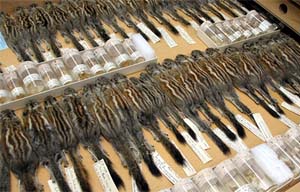 It's rather mind-boggling to walk into the storage rooms at UC Berkeley's Museum of Vertebrate Zoology. The rooms hold all manner of skulls, skeletons, pelts, and entire specimens that are intact in jars and drawers. I was there with Gabriela Quirós, the producer of the QUEST story "Resurveying California's Wildlife – 100 Years Later". The Museum is generally not open to the public, except on Cal Day, which is the University's annual open house celebration. Monica Albe, the Museum's bubbly Senior Museum Scientist, accompanied by her equally enthusiastic fellow scientist, Allison Shultz, gave us a tour.
It's rather mind-boggling to walk into the storage rooms at UC Berkeley's Museum of Vertebrate Zoology. The rooms hold all manner of skulls, skeletons, pelts, and entire specimens that are intact in jars and drawers. I was there with Gabriela Quirós, the producer of the QUEST story "Resurveying California's Wildlife – 100 Years Later". The Museum is generally not open to the public, except on Cal Day, which is the University's annual open house celebration. Monica Albe, the Museum's bubbly Senior Museum Scientist, accompanied by her equally enthusiastic fellow scientist, Allison Shultz, gave us a tour.
The Museum contains over 640,000 specimens of amphibians, reptiles, birds and mammals and 50,000 tissue samples that have been specially preserved since the turn of the last century. It's considered to be the largest university museum collection of its kind in the country. While it may even seem a bit disconcerting at first to see this enormous collection-- especially the specimens that have been stuffed to be appear more life-like-- the historical importance of the collection is tremendously significant.
Many of the specimens were collected in the early 1900's by the Museum's first Director, Dr. Joseph Grinnell, a zoologist who realized how quickly the environment was changing under the influence of human civilization. He set out to meticulously document various regions in California by amassing specimens and creating field notes, photographs, maps, letters and other archival materials. Grinnell understood how valuable this information would be in the years to come to future generations who wanted to learn more about our ever-evolving landscape. Present-day scientists are able to utilize this information for climate change research and can even extract DNA to perform genetic tests.
Monica is the Museum's preparator and oversees its Specimen Preparation Laboratory for UC Berkeley students. Veterinary hospitals or park employees donate specimens for her and her students to work on and she has a special license that allows her to collect any roadkill that she finds. The Museum usually preps specimens in three ways in order for scientists to have several options of study available to the: anatomy and biology (specimens that are prepared with taxidermy methods), skeletons, and entire specimens preserved in fluid. Monica even has a collection of dermestid beetles that help to completely clean the skeletons.
![]() Watch the "Resurveying California's Wildlife 100 Years Later" TV Story online, as well as find additional links and resources. Don't forget to see the behind-the-scenes photos from this story.
Watch the "Resurveying California's Wildlife 100 Years Later" TV Story online, as well as find additional links and resources. Don't forget to see the behind-the-scenes photos from this story.